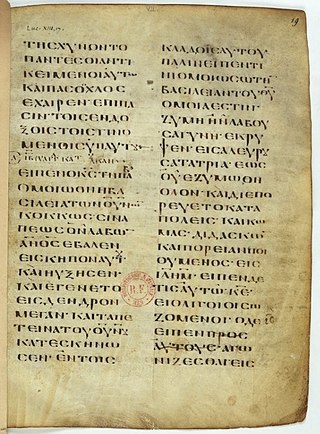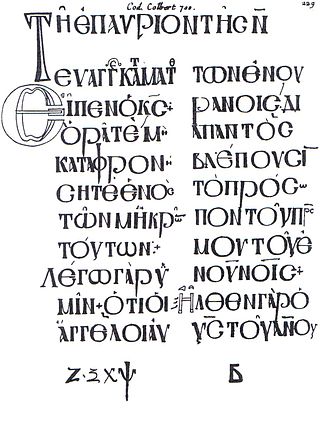| New Testament manuscript | |
| Text | Acts 6:5-7.13 |
|---|---|
| Date | 9th century |
| Script | Greek |
| Now at | Bibliothèque nationale de France |
| Size | 24 x 17 cm |
Uncial 0304 (in the Gregory-Aland numbering), is a Greek uncial manuscript of the New Testament. Palaeographically it has been assigned to the 9th century.
The codex contains a small texts of the Acts 6:5-7.13, on 1 parchment leaf (24 cm by 17 cm). The leaf has survived in a fragmentary condition. It is written in two columns per page, 31 lines per page, in uncial letters. [1]
Currently it is dated by the INTF to the 9th century. [1] [2]
It is currently housed at the Bibliothèque nationale de France (Gr. 1126 VII, fol. 160) in Paris. [1] [2]
Uncial 099, ε 47 (Soden); is a Greek uncial manuscript of the New Testament, assigned paleographically to the 7th-century.
Uncial 0100, ε 070 (Soden), is a Greek-Coptic diglot uncial manuscript of the New Testament. It is dated palaeographically to the 7th-century.
Uncial 0114, ε 53 ; is a Greek–Coptic diglot uncial manuscript of the New Testament, dated palaeographically to the 8th-century.

Uncial 0115, ε 57 (Soden); is a Greek uncial manuscript of the New Testament, dated paleographically to the 9th or 10th-century. Formerly it was labelled by Wa.
Uncial 0127, ε 54 (Soden), is a bilingual Greek–Coptic uncial manuscript of the New Testament, dated palaeographically to the 8th century.
Uncial 0128, ε 071 (Soden), is a Greek uncial manuscript of the New Testament, dated paleographically to the 9th-century.
Lectionary 1575, α 1037 (Soden), is a Greek-Coptic diglot lectionary manuscript of the New Testament, dated paleographically to the 9th-10th century.
Uncial 0295, is a Greek uncial manuscript of the New Testament. Palaeographically it has been assigned to the 9th century.
Uncial 0299, is a Greek-Coptic diglot uncial manuscript of the New Testament. Palaeographically it has been assigned to the 10th or 11th century.
Uncial 0301, is a Greek-Coptic diglot uncial manuscript of the New Testament. Paleographically it has been assigned to the 5th century.

Uncial 0303, is a Greek uncial manuscript of the New Testament. Paleographically it has been assigned to the 7th century.
Uncial 0305, is a Greek uncial manuscript of the New Testament. The survived fragment is too brief for certain dating on a basis of Paleography.

Lectionary 1, designated siglum ℓ1, is a Greek manuscript of the New Testament on vellum. Palaeographically it has been assigned to the 10th century. Formerly it was known as Codex Colbertinus 700, then Codex Regius 278.
Lectionary 2, designated siglum ℓ2, is a Greek manuscript of the New Testament on vellum. Palaeographically it has been assigned to the 10th century. Formerly it was variously dated. Scrivener dated it to the 9th century, Henri Omont to the 14th century, Gregory to the 10th century. In the present day it is unanimously dated to the 10th century.
Lectionary 17, designated by siglum ℓ17. It is a Greek manuscript of the New Testament, on vellum leaves. Palaeographically it has been assigned to the 9th-century.
Lectionary 63, designated by siglum ℓ63, is a Greek manuscript of the New Testament, on parchment leaves. It is a lectionary (Evangelistarion). Palaeographically it has been assigned to the 9th-century.
Lectionary 64, designated by siglum ℓ64, is a Greek manuscript of the New Testament, on parchment leaves. It is a lectionary (Evangelistarion). Palaeographically it has been assigned to the 9th-century.
Lectionary 65, designated by siglum ℓ65, is a Greek manuscript of the New Testament, on parchment leaves. It is a lectionary (Evangelistarion). Palaeographically it has been assigned to the 9th-century.
Lectionary 72 is a Greek manuscript of the New Testament, on vellum leaves. It is designated by siglum ℓ72. Palaeographically it has been assigned to the year 13th-century.
Lectionary 245, designated by siglum ℓ245 is a Greek manuscript of the New Testament, on parchment. Palaeographically it has been assigned to the 9th century. The manuscript has survived on only two leaves.